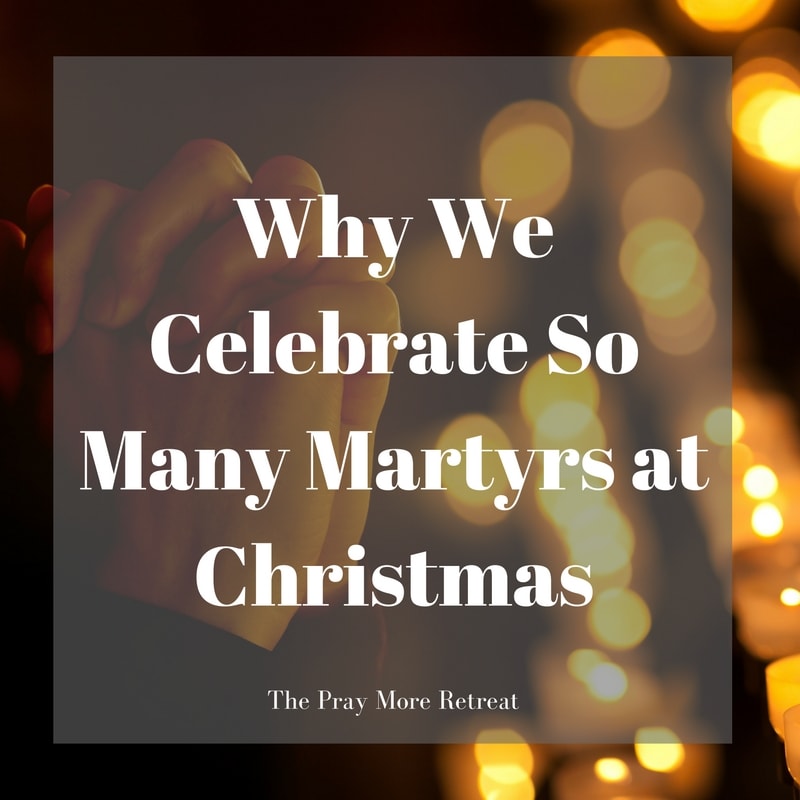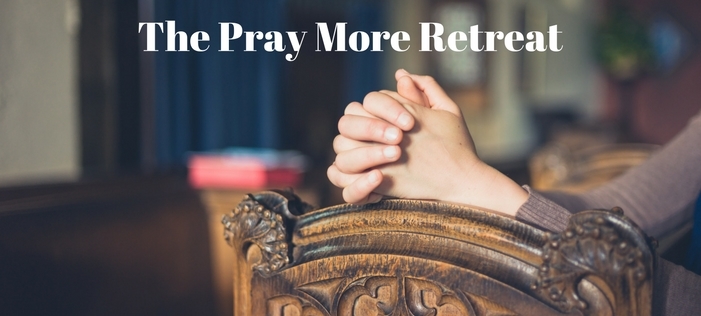Summary
Stephen Beale talks about the mystery of why there are so many martyrs being celebrated during the time of Christmas. He shares his insights and some passages and quotes to interpret this arrangement of the Church.
Thank you for watching and participating in this retreat!
Not Registered, yet? Don’t miss the rest of the talks! Register for the Pray More Retreat!
Downloads
Audio MP3
Click here to download audio file.
Printable Study Guide PDF
Click here to download the printable study guide.
Printable Transcript PDF
Click here to download the transcript of the video presentation.
Reflective Study Guide Questions
“The law of the Incarnation is a law of suffering. Our Blessed Lord was the man of sorrows, and by suffering, He redeemed the world. His passion was not a mystery detached from the rest of His life, but only the fitting and congruous end of it. Calvary was not unlike Bethlehem and Nazareth. It exceeded them in degree; it did not differ from then in kind. The whole of the Three-and-Thirty years was spent in consistent suffering, though it was of various kinds, and not of uniform intensity.”
Frederick William Faber
- Even though it is a somber and tragic thing that many martyrs had to die, their feast days also give us reason to celebrate their birth into Heaven. Similarly, even though we each carry a cross, it is possible to be joyful while carrying it. Think of how your cross, whatever it may be, is bringing you closer to Jesus, and ultimately, closer to Heaven. The next time that your cross is particularly painful, try to remember how God is allowing it to bring you closer to Him. Have you seen God’s hand in your suffering in the past, and why He may have allowed it to happen so that you could be brought closer to Him?
- Christ was born here on earth so that we can be born again into Heaven and have eternal life. Think of this Advent as a time to prepare for that birth — your birth into Heaven. What do you need to do to prepare to enter Heaven?
Text: Why We Celebrate So Many Martyrs at Christmas
Hello. My name is Stephen Beale. I’m a columnist at CatholicExchange.com, and I’m currently completing my Master’s degree in theology at Providence College. I’m pleased today to be sharing with you some of my reflections on advent. Before the formal beginning of our lecture, let’s just say a brief prayer.
Our Father
In the name of the Father, the Son, and the Holy Spirit. Amen. Our Father, who art in heaven, hallowed be thy name; thy kingdom come; thy will be done on earth as it is in heaven. Give us this day our daily bread, and forgive us our trespasses, as we forgive those who’ve trespassed against us. And lead us not into trial, but deliver us from evil. For thine is the kingdom, the power, and the glory, forever. Amen.
Celebrating Martyrdoms
So today, I’ll be speaking with you on the topic of why we celebrate so many martyrdoms around Christmas. Now, we tend to think of Christmas as the season of joy and the time of good tidings. So why is the liturgical calendar for this season packed with so many martyrdoms? Let’s take a look at just how many there are.
For example, the day after Christmas we celebrate the Feast of St. Stephen, who was the first martyr of the church who was stoned to death. The following Monday marks the Feast of the Holy Innocents, as babies of Bethlehem killed by the caprice of a tyrant. And next is St. Thomas Becket’s Feast Day, and his head was sliced open by a sword near the altar of a cathedral in medieval England. Moreover, we celebrate St. John the Apostle the Sunday after Christmas, and he is considered a martyr by will. And we also mark the feast day of St. John of Kanty, whose day is before Christmas Eve, and he longed to be a martyr.
So why do we have all of these martyrdoms around Christmas? Well, we can rule out one reason. According to the catholic encyclopedia, the scheduling of these feast days has nothing to do with the chronological order of the events. In other words, the church doesn’t celebrate these martyrs around Christmas out of a sense of obligation to historical accuracy and dating. It chose to celebrate these feasts at this time. But why this time? Why not have all of these martyrdoms commemorated at the end of lent? Would that not be a better time? Certainly, one can make a compelling argument for celebrating St. Stephen and St. John close to the day of the Lord’s passion, to which they were united. One by blood, and the other by will.
The Birthday of The Martyr
So, what is the church trying to tell us? Well, the answer really comes by considering what we celebrate on the feast day for a martyr. And we have to ask: Is it the day of their death? Well, yes, of course, it is that. But it’s more than that. And the history of one of the church’s earliest and most famous martyrs helps us to better understand what exactly it is we’re celebrating on the feast day for a martyr. That martyr is Polycarp. Now, as the story goes, he was sentenced to be burned, but the fire would not consume his body. So then he was pierced through the heart and burned again. Now, one early account of his martyrdom recounts Christians collecting his charred bones and bringing them to a place where his martyrdom would be celebrated. But it wasn’t the anniversary of his death that was necessarily commemorated. One early account describes it this way: “May God grant us to assemble with joy to celebrate the birthday of the martyr to his life in heaven. The birthday of the martyr in heaven.” In this truly not what we celebrate on the feast day for a martyr? Not their death, but their birth into a new life, the abundance of eternal life in heaven.
So, in a sense, it’s really more of a birthday rather than a day of death that we celebrate when we celebrate the feast day of a martyr. That is why even though their deaths drive a somber note in us, there’s also a strong undercurrent of joy in these feast days. So explains Thomas Becket’s fictional character in T. S. Eliot’s play Murder in the Cathedral. “Just as we rejoice and mourn at once in the birth and in the passion of our Lord, so also in a small figure we both rejoice and mourn in the death of martyrs. We mourn, for the sins of the world that has martyred them; we rejoice that another soul is numbered among the saints of heaven.” And here, I’d like to briefly explore a deeper connection between these martyrs’ feasts and the date of Christmas. And it was already kind of hinted at a little bit in that quotation I just read you from T. S. Eliot. And the connection is this: That embedded deep within the consciousness of the church and the Christmas mind, there’s always been this close association between the birth of Christ and his death. In fact, many spiritual writers and doctors of the church suggest that his passion in a way began at his birth. For example, here is what great 19th century spiritual writer, Father Frederick William Faber, says about it in his classic work At The Foot of the Cross. This is also titled The Sorrows of Mary. “The law of the incarnation is a law of suffering. Our blessed Lord was the man of sorrows, and by suffering he redeemed the world. His passion was not a mystery detached from the rest of his life, but only the fitting and congruous end to it.” Calvary was not unlike Bethlehem and Nazareth. It exceeded them in degree, but it did not differ from them in kind. The whole of the 33 years was spent in consistent suffering, though it was of various kinds, and not of uniform intensity.”
In fact, in this same passage, Father Faber makes the connection with the Holy Innocence, which we have just discussed above. “This same law of suffering, which belongs to Jesus, touches all who come nigh Him, and in proportion to their holiness, envelops them, and claims them wholly for itself. The Holy Innocents were, in the counsels of God, simply our Lord’s contemporaries, but that is similitude enough to plunge them in a sea of suffering.” This connection between the incarnation and the passion goes all the way back to the Fathers of the church. And this is reflected in the fact that the early church believed that Jesus’ death and birth were the same dates of their respective months – the 25th of December and the 25th of March.
This is according to a historical theologian, and he notes that this was recorded in one church Father, named Tertullian, who was writing around 200 AD. It was also mentioned in a fourth-century text titled On Solstices and Equinoxes. And Augustine, one of his sermons picks up on this idea and develops it further. “For He, that is Jesus, is believed to have been conceived on the 25th of March, upon which day He also suffered. So the womb of the virgin of which He was conceived, where no one of mortals was begotten, corresponds to the new grave in which He was buried, wherein was never a man laid. Neither before Him nor since. He was born, according to tradition, on December 25 .”
Remind Us of The Purpose
So I want to conclude by bringing us back to our initial question: Why does the church celebrate so many martyrdoms around the day of Christmas? Well, now we’re in a much better position to answer this question. And I think a clear answer is that these martyrs remind us of Christ’s own passion, which began at his birth. They remind us of the purpose for which he was born, and it was this: Christ was born here on earth so that we might be born again into heaven. Again, Christ was born to die so that we might have eternal life. And that is why the so-called birthdays of these martyrs into heaven is celebrated around the same time as Christ’s birthday on earth.
Well, I thank you for listening today. I’ve been very pleased to share my reflections on advent with you. I wish you a blessed advent. So God bless, and have a good day.
About Stephen Beale

Stephen Beale is a freelance writer and reporter based in Providence, Rhode Island. Raised as an evangelical Protestant, he is a convert to Catholicism. He writes a weekly column for CatholicExchange and also is a regular contributor to the National Catholic Register and Crisis magazine. He holds a B.A. in classics and history from Brown University. He also has completed the coursework towards an MA in theology at Providence College, where he has focused on the thought and spirituality of the early Church Fathers.

